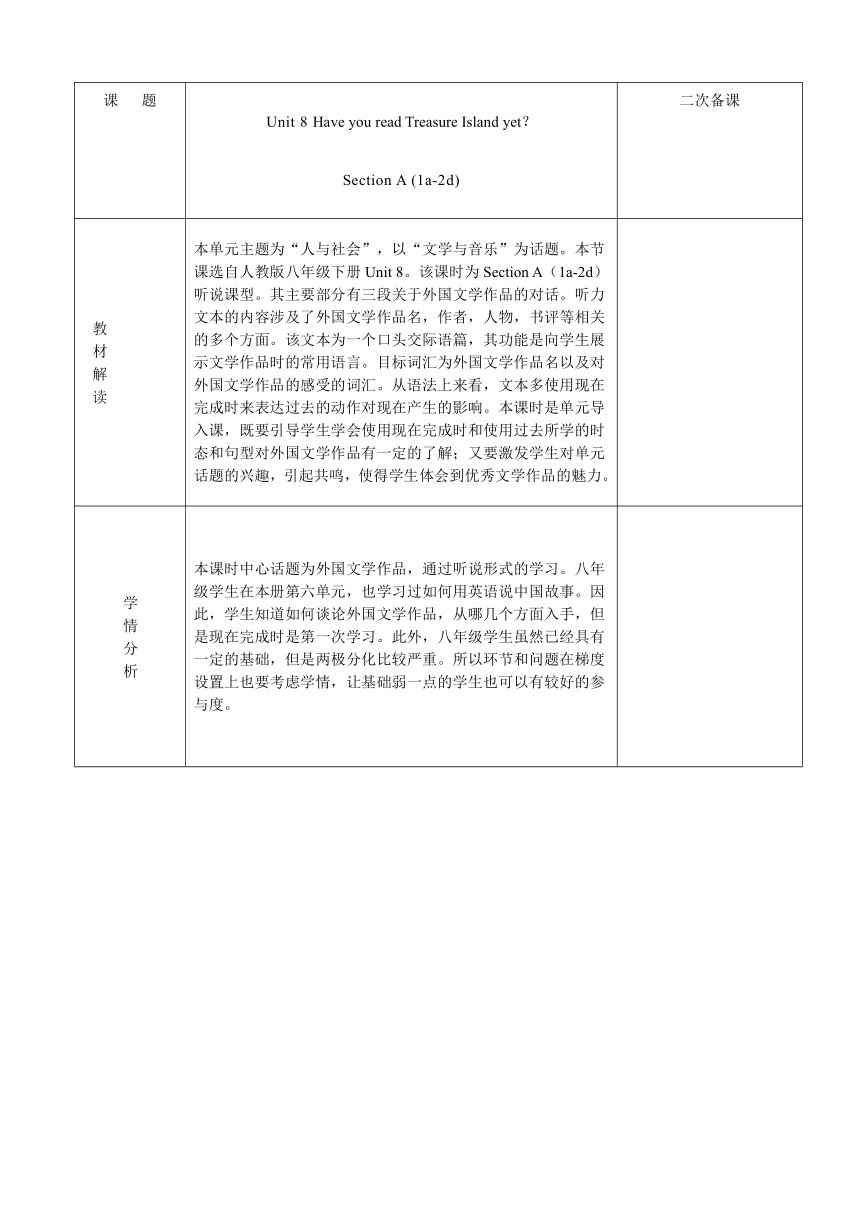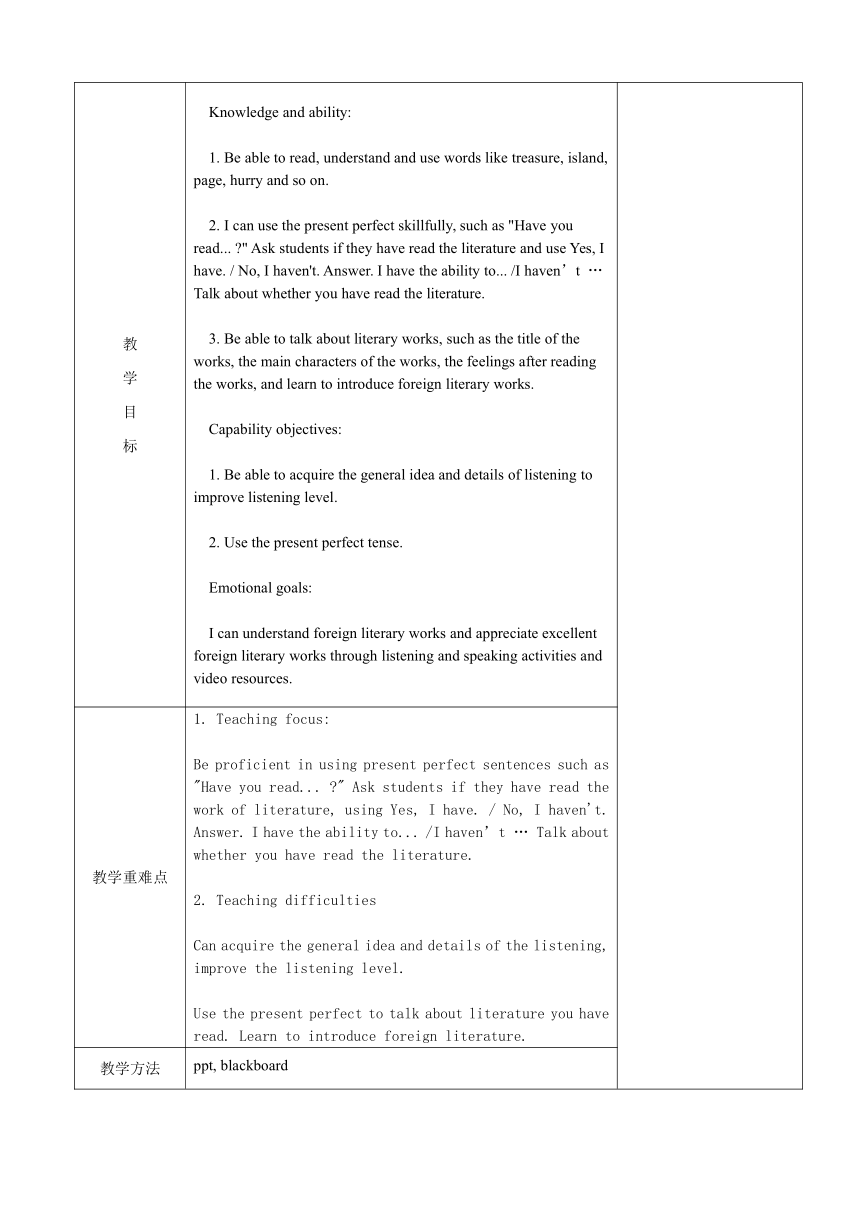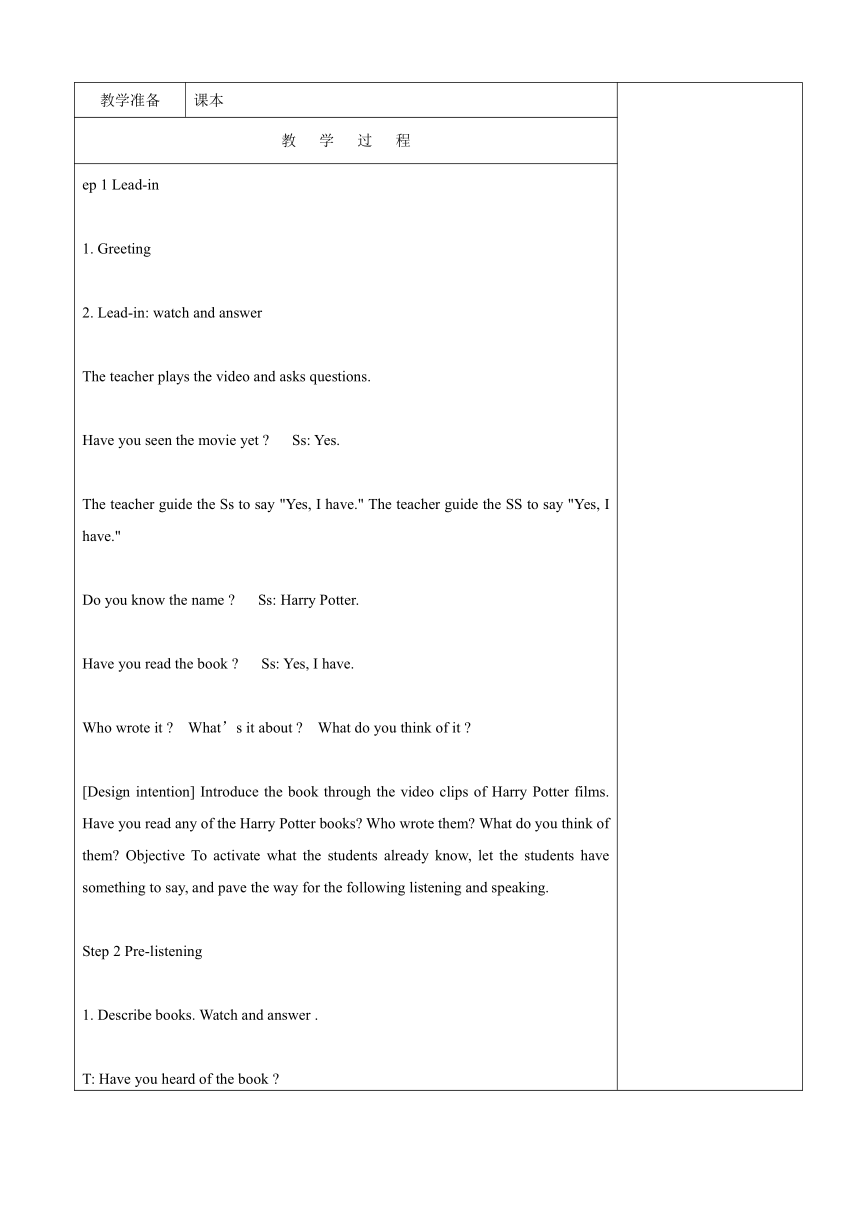教案八年级下册Unit 8 Have you read Treasure Island yet? Period 1 SectionA 1a-2d(表格式)
文档属性
| 名称 | 教案八年级下册Unit 8 Have you read Treasure Island yet? Period 1 SectionA 1a-2d(表格式) |

|
|
| 格式 | doc | ||
| 文件大小 | 45.5KB | ||
| 资源类型 | 教案 | ||
| 版本资源 | 人教新目标(Go for it)版 | ||
| 科目 | 英语 | ||
| 更新时间 | 2023-05-23 20:18:32 | ||
图片预览



文档简介
课 题 Unit 8 Have you read Treasure Island yet?Section A (1a-2d) 二次备课
教 材 解 读 本单元主题为“人与社会”,以“文学与音乐”为话题。本节课选自人教版八年级下册Unit 8。该课时为Section A(1a-2d)听说课型。其主要部分有三段关于外国文学作品的对话。听力文本的内容涉及了外国文学作品名,作者,人物,书评等相关的多个方面。该文本为一个口头交际语篇,其功能是向学生展示文学作品时的常用语言。目标词汇为外国文学作品名以及对外国文学作品的感受的词汇。从语法上来看,文本多使用现在完成时来表达过去的动作对现在产生的影响。本课时是单元导入课,既要引导学生学会使用现在完成时和使用过去所学的时态和句型对外国文学作品有一定的了解;又要激发学生对单元话题的兴趣,引起共鸣,使得学生体会到优秀文学作品的魅力。
学 情 分 析 本课时中心话题为外国文学作品,通过听说形式的学习。八年级学生在本册第六单元,也学习过如何用英语说中国故事。因此,学生知道如何谈论外国文学作品,从哪几个方面入手,但是现在完成时是第一次学习。此外,八年级学生虽然已经具有一定的基础,但是两极分化比较严重。所以环节和问题在梯度设置上也要考虑学情,让基础弱一点的学生也可以有较好的参与度。
教 学 目标 Knowledge and ability:1. Be able to read, understand and use words like treasure, island, page, hurry and so on.2. I can use the present perfect skillfully, such as "Have you read... " Ask students if they have read the literature and use Yes, I have. / No, I haven't. Answer. I have the ability to... /I haven’t … Talk about whether you have read the literature.3. Be able to talk about literary works, such as the title of the works, the main characters of the works, the feelings after reading the works, and learn to introduce foreign literary works.Capability objectives:1. Be able to acquire the general idea and details of listening to improve listening level.2. Use the present perfect tense.Emotional goals:I can understand foreign literary works and appreciate excellent foreign literary works through listening and speaking activities and video resources.
教学重难点 1. Teaching focus:Be proficient in using present perfect sentences such as "Have you read... " Ask students if they have read the work of literature, using Yes, I have. / No, I haven't. Answer. I have the ability to... /I haven’t … Talk about whether you have read the literature.2. Teaching difficultiesCan acquire the general idea and details of the listening, improve the listening level.Use the present perfect to talk about literature you have read. Learn to introduce foreign literature.
教学方法 ppt, blackboard
教学准备 课本
教 学 过 程
ep 1 Lead-in1. Greeting2. Lead-in: watch and answerThe teacher plays the video and asks questions.Have you seen the movie yet Ss: Yes.The teacher guide the Ss to say "Yes, I have." The teacher guide the SS to say "Yes, I have."Do you know the name Ss: Harry Potter.Have you read the book Ss: Yes, I have.Who wrote it What’s it about What do you think of it [Design intention] Introduce the book through the video clips of Harry Potter films. Have you read any of the Harry Potter books Who wrote them What do you think of them Objective To activate what the students already know, let the students have something to say, and pave the way for the following listening and speaking.Step 2 Pre-listening1. Describe books. Watch and answer .T: Have you heard of the book Ss: Yes, I have. No, I haven’t.T: I have/haven’t heard of…2.Match game. Ask the students to match .3.Do exercise in 1a.[Design intention] Introduce foreign literary works through multi-modal teaching methods such as pictures, text and video before listening. Here, students are guided to engage in "appreciative listening," choosing the information that will stimulate their interest. When each literary work appeared, students were asked whether they had read the literary work in the perfect interrogative form. Then students were instructed to use the present perfect declarative form to express whether they had or had not read the literary work. Use Siwo knowledge matching game to consolidate the Chinese and English names in literature. Ask students to do it on the platform to increase the interaction with students. The book 1a activity, but also for the next listening activities to pave the way.Step 3 While-listening1. Material 1 (1b)Listen and write the book title.Listen and answer. Have they read it What do they think of it 2. Practice in pairs, then show it. (1c)3. Material 2Listen and answer. Who has read these books Circle the names. (2a Sivo Class activities fun classification)Listen for more details to know more about the works. (2b) Listen for more details to know more about the works. (2B)【 Design Intention 】 The first paragraph of the listening text. It is mainly "informational listening", where students listen to foreign literature and whether students have read the work (ask the present perfect). Listen to the key information in the exam. The students were then instructed to engage in "empathic listening", listening to others' comments on literary works. Use the first paragraph of listening material, create oral activities, internalize the corpus content. Practice target conversations in pairs to provide background knowledge, vocabulary and sentence patterns for formal listening. The second part of the listening text is also mainly "informational listening". Listen to the details of the test.Step 4 Post-listening1. Talk about the books mentioned in 2a and 2b. Ask the students to work in pairs to drill the structure.2. Listen and read 2d, answer the questions to know more about Little Women. (Siwo class activities fun selection)3. Know how to talk about a book.4. Teach language points in 2d.5. Repeat the dialogue.[Design intention] Exercise students' ability to acquire information by listening to dialogues. Listen to the passage and answer the questions. Lower the difficulty and answer general questions and special questions. Use mind maps to help students learn how to write a book report and introduce literature to others in English.Step 5 Summary1.Summarize what we have learned : words, sentences, present perfect tense and listening skills.2d introduces the literary work Little Women. Make use of the famous words of the literary work Little Women and the arrival of the World Reading Day to let students read more excellent literary works.[Design intention] sublimate emotion, open book beneficial. In conjunction with World Book Day, encourage students to read.Step 6 Homework1.Must-do: I have/haven’t read … Make a sentence.2.Must-do: Write down a book report. Do a short oral report.3.Optional :Make a video to introduce a book[Design intention] Introduce a foreign literary work you have read, either in text form or by recording a short video.
教 学 反 思
在师生互动设计中,学生能够在老师指导下积极主动地完成各项练习,学习目标能较好完成。整个听说课,以介绍外国文学作品为主线贯穿全课堂。听前,学生对有关背景知识的了解程度会影响其理解的质量。听前活动就是去激活相关的图式,使这种图式在学生头脑中活跃起来,学生就能对要听的材料形成整体概念,对要听的内容产生期待。听前活动,教师的角色是互动活动的组织者。教师先通过哈利波特电影,引导学生对其作者,内容,书评进行讨论,激起学生的兴趣。教师利用图像,电影视频等对学生的视觉听觉刺激,有利于激活听力图式,提高理解效果和听力水平。再利用希沃课堂活动,知识配对,与学生互动。在轻松愉快的听前活动中,吸引学生积极主动地参与到听力活动中来。听中,教师作为互动活动的调控者、指导者和参与者,要引导学生学会使用听力技巧的策略,对自己的听力活动进行控制,从而很好地理解语料大意和主要细节。该课听力材料有三段,培养学生的听力技能。如听细节,推断,有选择性地听。为了培养这些能力,听力的活动形式有:听写书名,正误判断,选择。听的方式,精听,选听,泛听相结合,并各有侧重。听后活动,以听带说,教师要引导学生运用听到的材料内容跟或语言进行听后说。学生可以根据前面所听到的内容进行口语练习,如对听力材料进行创造性的语言输出,评论和表达自己的观点。一方面提高了学生的口语能力,达到培养学生交际能力的目的,另一方面也丰富了学生头脑中的知识和知识结构。整个课堂通过前期知识背景的输入,听中对话学习,听后文本提取并归纳总结,搭建口语输出的支架,从而让学生熟练掌握相关表达,流利自信地介绍文学作品。不足之处:教学中停留在聆听层面,以听力技能策略教学、语言知识教学、语音教学或听说结合探索为重点。应该要聚焦学生语言能力、共情能力和欣赏能力发展的英语教学模式。在教学中,教师要结合文本,引导学生进行“移情式倾听”和“欣赏式倾听”,将听力还原到学生实际生活中的交际,契合学生实际生活的交际需求。我应该先尝试用现在完成时询问学生是否读过四大名著之类,这样更体现了以学生为主体的教学理念,因为很多学生并了解这些外国文学作品。有条件的地区,还可以上课前先用问卷星调查,学生对外国文学作品的了解情况。我的这堂课的设计并不适合语言能力较弱的学生。如果要在英语听力教学课堂中实现“移情式倾听”和“欣赏式倾听”最佳效果,需要整体设计并长期进行实践。
教 材 解 读 本单元主题为“人与社会”,以“文学与音乐”为话题。本节课选自人教版八年级下册Unit 8。该课时为Section A(1a-2d)听说课型。其主要部分有三段关于外国文学作品的对话。听力文本的内容涉及了外国文学作品名,作者,人物,书评等相关的多个方面。该文本为一个口头交际语篇,其功能是向学生展示文学作品时的常用语言。目标词汇为外国文学作品名以及对外国文学作品的感受的词汇。从语法上来看,文本多使用现在完成时来表达过去的动作对现在产生的影响。本课时是单元导入课,既要引导学生学会使用现在完成时和使用过去所学的时态和句型对外国文学作品有一定的了解;又要激发学生对单元话题的兴趣,引起共鸣,使得学生体会到优秀文学作品的魅力。
学 情 分 析 本课时中心话题为外国文学作品,通过听说形式的学习。八年级学生在本册第六单元,也学习过如何用英语说中国故事。因此,学生知道如何谈论外国文学作品,从哪几个方面入手,但是现在完成时是第一次学习。此外,八年级学生虽然已经具有一定的基础,但是两极分化比较严重。所以环节和问题在梯度设置上也要考虑学情,让基础弱一点的学生也可以有较好的参与度。
教 学 目标 Knowledge and ability:1. Be able to read, understand and use words like treasure, island, page, hurry and so on.2. I can use the present perfect skillfully, such as "Have you read... " Ask students if they have read the literature and use Yes, I have. / No, I haven't. Answer. I have the ability to... /I haven’t … Talk about whether you have read the literature.3. Be able to talk about literary works, such as the title of the works, the main characters of the works, the feelings after reading the works, and learn to introduce foreign literary works.Capability objectives:1. Be able to acquire the general idea and details of listening to improve listening level.2. Use the present perfect tense.Emotional goals:I can understand foreign literary works and appreciate excellent foreign literary works through listening and speaking activities and video resources.
教学重难点 1. Teaching focus:Be proficient in using present perfect sentences such as "Have you read... " Ask students if they have read the work of literature, using Yes, I have. / No, I haven't. Answer. I have the ability to... /I haven’t … Talk about whether you have read the literature.2. Teaching difficultiesCan acquire the general idea and details of the listening, improve the listening level.Use the present perfect to talk about literature you have read. Learn to introduce foreign literature.
教学方法 ppt, blackboard
教学准备 课本
教 学 过 程
ep 1 Lead-in1. Greeting2. Lead-in: watch and answerThe teacher plays the video and asks questions.Have you seen the movie yet Ss: Yes.The teacher guide the Ss to say "Yes, I have." The teacher guide the SS to say "Yes, I have."Do you know the name Ss: Harry Potter.Have you read the book Ss: Yes, I have.Who wrote it What’s it about What do you think of it [Design intention] Introduce the book through the video clips of Harry Potter films. Have you read any of the Harry Potter books Who wrote them What do you think of them Objective To activate what the students already know, let the students have something to say, and pave the way for the following listening and speaking.Step 2 Pre-listening1. Describe books. Watch and answer .T: Have you heard of the book Ss: Yes, I have. No, I haven’t.T: I have/haven’t heard of…2.Match game. Ask the students to match .3.Do exercise in 1a.[Design intention] Introduce foreign literary works through multi-modal teaching methods such as pictures, text and video before listening. Here, students are guided to engage in "appreciative listening," choosing the information that will stimulate their interest. When each literary work appeared, students were asked whether they had read the literary work in the perfect interrogative form. Then students were instructed to use the present perfect declarative form to express whether they had or had not read the literary work. Use Siwo knowledge matching game to consolidate the Chinese and English names in literature. Ask students to do it on the platform to increase the interaction with students. The book 1a activity, but also for the next listening activities to pave the way.Step 3 While-listening1. Material 1 (1b)Listen and write the book title.Listen and answer. Have they read it What do they think of it 2. Practice in pairs, then show it. (1c)3. Material 2Listen and answer. Who has read these books Circle the names. (2a Sivo Class activities fun classification)Listen for more details to know more about the works. (2b) Listen for more details to know more about the works. (2B)【 Design Intention 】 The first paragraph of the listening text. It is mainly "informational listening", where students listen to foreign literature and whether students have read the work (ask the present perfect). Listen to the key information in the exam. The students were then instructed to engage in "empathic listening", listening to others' comments on literary works. Use the first paragraph of listening material, create oral activities, internalize the corpus content. Practice target conversations in pairs to provide background knowledge, vocabulary and sentence patterns for formal listening. The second part of the listening text is also mainly "informational listening". Listen to the details of the test.Step 4 Post-listening1. Talk about the books mentioned in 2a and 2b. Ask the students to work in pairs to drill the structure.2. Listen and read 2d, answer the questions to know more about Little Women. (Siwo class activities fun selection)3. Know how to talk about a book.4. Teach language points in 2d.5. Repeat the dialogue.[Design intention] Exercise students' ability to acquire information by listening to dialogues. Listen to the passage and answer the questions. Lower the difficulty and answer general questions and special questions. Use mind maps to help students learn how to write a book report and introduce literature to others in English.Step 5 Summary1.Summarize what we have learned : words, sentences, present perfect tense and listening skills.2d introduces the literary work Little Women. Make use of the famous words of the literary work Little Women and the arrival of the World Reading Day to let students read more excellent literary works.[Design intention] sublimate emotion, open book beneficial. In conjunction with World Book Day, encourage students to read.Step 6 Homework1.Must-do: I have/haven’t read … Make a sentence.2.Must-do: Write down a book report. Do a short oral report.3.Optional :Make a video to introduce a book[Design intention] Introduce a foreign literary work you have read, either in text form or by recording a short video.
教 学 反 思
在师生互动设计中,学生能够在老师指导下积极主动地完成各项练习,学习目标能较好完成。整个听说课,以介绍外国文学作品为主线贯穿全课堂。听前,学生对有关背景知识的了解程度会影响其理解的质量。听前活动就是去激活相关的图式,使这种图式在学生头脑中活跃起来,学生就能对要听的材料形成整体概念,对要听的内容产生期待。听前活动,教师的角色是互动活动的组织者。教师先通过哈利波特电影,引导学生对其作者,内容,书评进行讨论,激起学生的兴趣。教师利用图像,电影视频等对学生的视觉听觉刺激,有利于激活听力图式,提高理解效果和听力水平。再利用希沃课堂活动,知识配对,与学生互动。在轻松愉快的听前活动中,吸引学生积极主动地参与到听力活动中来。听中,教师作为互动活动的调控者、指导者和参与者,要引导学生学会使用听力技巧的策略,对自己的听力活动进行控制,从而很好地理解语料大意和主要细节。该课听力材料有三段,培养学生的听力技能。如听细节,推断,有选择性地听。为了培养这些能力,听力的活动形式有:听写书名,正误判断,选择。听的方式,精听,选听,泛听相结合,并各有侧重。听后活动,以听带说,教师要引导学生运用听到的材料内容跟或语言进行听后说。学生可以根据前面所听到的内容进行口语练习,如对听力材料进行创造性的语言输出,评论和表达自己的观点。一方面提高了学生的口语能力,达到培养学生交际能力的目的,另一方面也丰富了学生头脑中的知识和知识结构。整个课堂通过前期知识背景的输入,听中对话学习,听后文本提取并归纳总结,搭建口语输出的支架,从而让学生熟练掌握相关表达,流利自信地介绍文学作品。不足之处:教学中停留在聆听层面,以听力技能策略教学、语言知识教学、语音教学或听说结合探索为重点。应该要聚焦学生语言能力、共情能力和欣赏能力发展的英语教学模式。在教学中,教师要结合文本,引导学生进行“移情式倾听”和“欣赏式倾听”,将听力还原到学生实际生活中的交际,契合学生实际生活的交际需求。我应该先尝试用现在完成时询问学生是否读过四大名著之类,这样更体现了以学生为主体的教学理念,因为很多学生并了解这些外国文学作品。有条件的地区,还可以上课前先用问卷星调查,学生对外国文学作品的了解情况。我的这堂课的设计并不适合语言能力较弱的学生。如果要在英语听力教学课堂中实现“移情式倾听”和“欣赏式倾听”最佳效果,需要整体设计并长期进行实践。
同课章节目录
- Unit 1 What's the matter?
- Section A
- Section B
- Unit 2 I'll help to clean up the city parks.
- Section A
- Section B
- Unit 3 Could you please clean your room?
- Section A
- Section B
- Unit 4 Why don't you talk to your parents?
- Section A
- Section B
- Unit 5 What were you doing when the rainstorm came
- Section A
- Section B
- Review of Units 1-5
- Unit 6 An old man tried to move the mountains.
- Section A
- Section B
- Unit 7 What's the highest mountain in the world?
- Section A
- Section B
- Unit 8 Have you read Treasure Island yet?
- Section A
- Section B
- Unit 9 Have you ever been to a museum?
- Section A
- Section B
- Unit 10 I've had this bike for three years.
- Section A
- Section B
